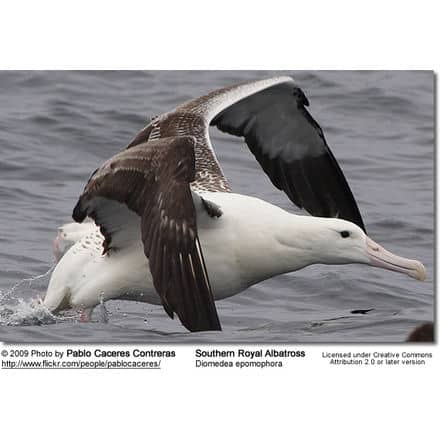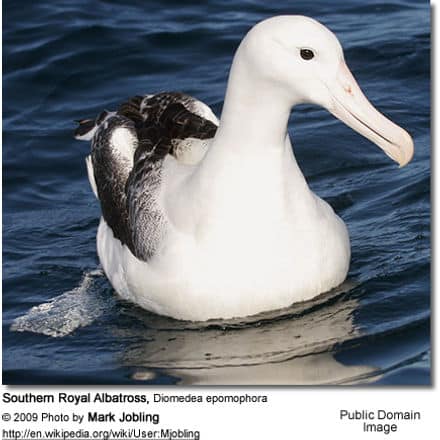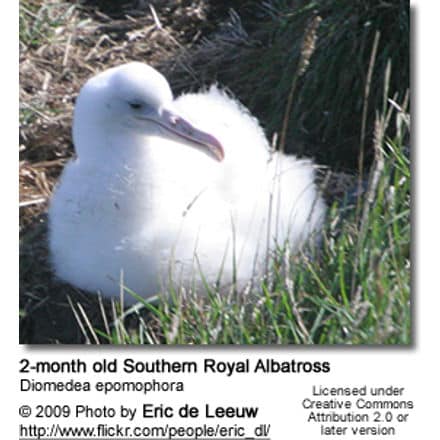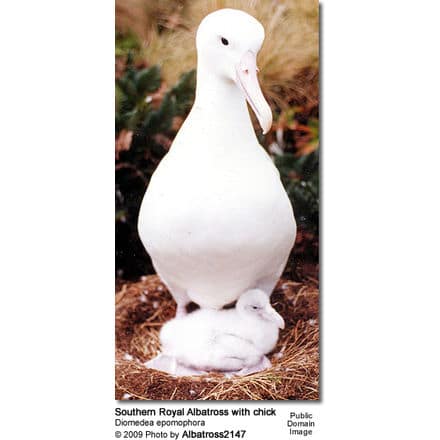Southern Royal Albatross (Diomedea epomophora)
The Southern Royal Albatrosses, (Diomedea epomophora), is a large seabird from the albatross family. At an average wingspan of almost 3 m (9.8 ft), it is the second largest albatross, behind the Wandering Albatross.

Description
The Southern Royal Albatrosses has a length of 115–123 cm (45–48 in) and a weight of 8.5 kg (19 lb).
The juvenile has a white head, neck, upper mantle, rump, and underparts. There are black speckles on the mantle, and they have dark brown or black wings with white flecks on the cover.
Their tail is white except for the black tip as is the under-wing. As they age the back, wings, and tail. All ages have a pink bill with black on the cutting edge on the upper mandible (bill), and the legs are flesh.
The average life span is 42.3 years.
Similar Species:
They are hard to differentiate from the Northern Royal Albatross and the Wandering Albatross, with the Southern having white on the upper wing.

Range
The majority of the world’s population of Southern Royal Albatrosses nest on the rat-free Sub-antarctic Campbell Island (New Zealand), around 8,200 to 8,600 pairs.
There are smaller colonies on Adams Island and Auckland Island in the Auckland Islands,20 pairs combined, 69 pairs on Enderby Island, and some sanfordi X epomophora hybrids at the Northern Royal Albatross colony on the Otago Peninsula in New Zealand.
They range along the southern oceans concentrating on the west and east coast of southern South America, and also in the waters surrounding New Zealand.
| Location | Population | Date | Trend |
| Campbell Islands | 8,200-8,600 pair | 1997 | Stable |
| Enderby Island | 69 pair | 2001 | Stable |
| Auckland Island and Adams Island | 20 pair | 2001 | Stable |
| Total | 28,000-29,500 | 1997 | Stable |
Feeding
The Southern Royal Albatrosses eats squid and fish, with smaller amounts of carrion (animal carcasses), crustaceans, and salps.
Reproduction
They prefer to nest on tussock grassland, plateaus, or ridges and will lay one egg biennially (every second year).
Both parents will incubate the egg, and rear the young. When feeding the young they will range south to the Campbell Plateau and north to the Chatham Rise.
Conservation
The IUCN classifies this bird as Vulnerable, with an occurrence range of 63,400,000 km2 (24,500,000 sq mi), and a breeding range of 750 km2 (290 sq mi) with a total estimated population of between 28,000 and 29,500 (1997).
The population is recovering from its severe downward spiral in the late 19th century and the early 20th century. By the 1880s, this Albatross was extirpated from Auckland Island and Enderby Island.
Pigs and cats are still a problem, as they take chicks and eggs, on Auckland Island. Longline fishing is a major problem and a possible emerging threat in Dracophyllum, a scrub that is taking away from their nesting range.
Taxonomy
Albatrosses belong to the Diomedeidae family and come from the Procellariiformes order, along with Shearwaters, Fulmars, Storm-petrels, and Diving-petrels.
They share certain identifying features. First, they have nasal passages that attach to the upper bill called naricorns.
Although the nostrils on the Albatross are on the sides of the bill. The bills of Procellariiformes are also unique in that they are split into between 7 and 9 horny plates.
Finally, they produce a stomach oil made up of wax esters and triglycerides that are stored in the proventriculus (stomach). This is used against predators as well as an energy-rich food source for chicks and for adults during their long flights.
It was once considered conspecific (of, or belonging to, the same species) with the Northern Royal Albatross (Diomedea sanfordi) as the Royal Albatross, and the split into two species is almost universally accepted. BirdLife International, Brooke, and Robertson, and Nunn. Clements still does not recognize the split, and the SACC has recognized the need for a proposal.
Etymology
Diomedea antipodensis breaks into Diomedea referring to Diomedes (hero in Greek mythology), whose companions turned to birds.





